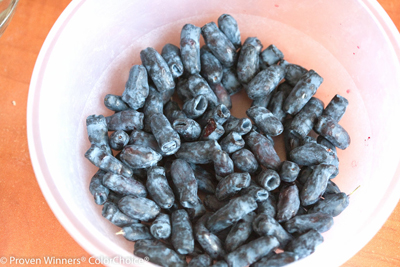Yazberry® Sweetberry Honeysuckle Lonicera caerulea
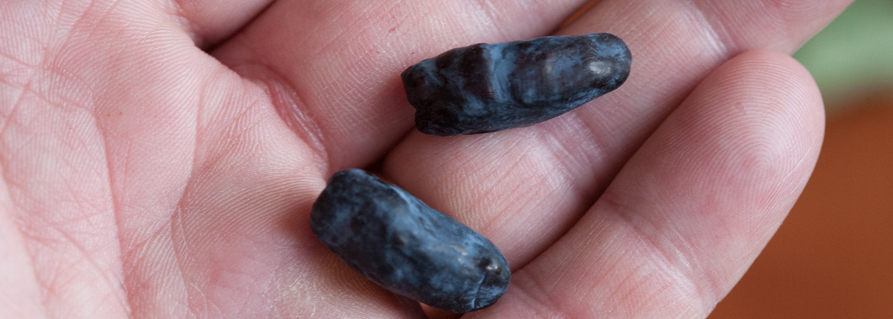
Sweetberry honeysuckles look like an oversized, elongated blueberry. They are not only easier to grow than blueberries, but they also contain far higher levels of antioxidants and three times the amount of vitamin C. They are one of the hardiest edible plants on earth, tolerating temperatures as cold as -50°F (-45.6°C).
Sugar Mountain® Blue was specially selected in the Czech Republic for its extra-large, luscious fruits. Once you taste these berries, you won’t be able to get enough, and planting a pollinator variety with Sugar Mountain® Blue will provide the most abundant fruit set - look for Sugar Mountain® Balalaika™, Eisbär™, or Kalinka™. Sweetberry honeysuckles can be eaten fresh right from the bush, cooked into jam, pressed for juice, or made into sauce or pie
filling. The fruits can also be dried or frozen to enjoy a taste of summer on a cold winter’s night.
Zone: Hardy to USDA zone 1, heat tolerant to AHS zone 6
Exposure: Full sun (6+ hours)
Height: 5-6’ (1.5-1.8 m) tall
Water: Average water needs; tolerant of some drought once established.
Soil: Adaptable to any well-drained soil, regardless of pH. Grows best with abundant organic matter,
and the use of a shredded bark mulch is recommended.
Pollinators: Plant any pollinator variety within 25’ (7.6 m) of Sugar Mountain® Blue for best fruit set. Planting
just one shrub will result in far fewer and much smaller fruits.
Pests: Sweetberry honeysuckles are generally not bothered by deer. Birds may eat the berries as they
ripen, but can be deterred by draping plants with bird netting. Powdery mildew may appear during
periods of excessive humidity, however, it is not a serious threat to the plant’s health. Site in full
sun and with good air circulation to minimize this fungal disease.
Pruning: Plants should not be pruned until they have spent three years in the ground. After that, remove
any dead wood and thin congested portions of the plant to encourage new growth elsewhere. Cut
back tips of stems to encourage branching, as lateral branches bear more fruit. Prune immediately
after harvest ONLY. Sweetberry honeysuckles flower and fruit on old wood, so pruning at any
other time of the year will reduce fruit set.
Harvesting: The berries begin to ripen in early summer, around the same time as strawberries. Sugar
Mountain™ Blue ripens more evenly than traditional sweetberry honeysuckle varieties. They
shift from green to blue-purple with a waxy white bloom. The superficial color change does not
necessarily indicate ripeness, however; unripe berries are sour and green inside, rather than a
plum-like purple. Taste fruits or cut in half to determine readiness. Be patient; it may take several
weeks after the skin changes color. Ripe berries hold well on the plant for several weeks, so you
can wait until a large quantity is ready to harvest at once if you prefer.
Fertilizing: These tolerant, adaptable plants do not need a highly fertile environment to grow well. However,
a granular fertilizer formulated for woody plants applied at bud-break each spring helps to
encourage the formation of strong, abundant growth which will bear heavily the following season.
Keys to Sweetberry Honeysuckle Success:
- Plants flower and fruit on old wood, so if pruning is required, do so immediately after harvest.
- Plant two different varieties for pollination. Planting two for example, will not boost fruit production, but planting one and one pollinator variety like , will. Research has shown that one pollinator to every 24 fruiting plants is sufficient in an orchard setting.
- Because plants fruit on old wood, your crops for the first few years may be hidden deep within the plant. Don’t miss them! Spread the branches apart and look for them closer to the base of the plant.
FAQ
What do the berries taste like?
Everyone describes their flavor differently. Many compare their taste to a cross between a blueberry and raspberry or blackberry. Their texture is similar to a blueberry, however, and the skin is very thin, soft, and melts in your mouth. They are sweet enough to eat straight from the plant.
Do the berries have seeds?
Sweetberry honeysuckle berries do have seeds, however, they are very small and not really noticeable much like in a blueberry.
Is sweetberry honeysuckle a vine or shrub type honeysuckle?
Shrub type. It forms an attractive, rounded, upright habit and does not need any kind of support or staking.
Is it invasive?
Though many honeysuckles are problematic invasive plants, sweetberry honeysuckle has shown no signs of invasiveness anywhere it is grown. It does not run or sucker.
How far apart can I plant my two varieties and still get fruit?
Sugar Mountain® Blue Sweetberry honeysuckle flowers in the earliest days of spring, when insects are still quite weak from their
winter dormancy. Therefore, shrubs planted closer together have a better chance at pollination than those planted far apart. Though you will likely still get fruit if you plant one in your front yard and the other in your back yard, you will get significantly more fruit if they are planted within 10’ of one another. If spacing them closely, place them about 5’ apart to allow for maximum growth.
Are they like a holly, where only one of the two plants will get fruit?
No. Every variety of Yazberry® Sweetberry honeysuckle produces fruit because unlike holly, they have both male and female parts in every flower.
You need to plant two different varieties only because each plant fruits best when it receives pollen from an individual with different characteristics than its own.
Recipe ideas:
Sweetberry honeysuckles are so tasty, you’re likely to eat them straight from the bush! But should you find yourself with a cup or so of these luscious fruits that you wish to transform into something spectacular, try this versatile compote. It can be spooned over ice cream; drizzled over yogurt or oatmeal; or dolloped atop pancakes, waffles, or sponge cake.
Yazberry® Compote
Place sweetberry honeysuckle berries in small saucepan. Sprinkle ½ cup of sugar over them, and turn on medium low heat. The berries should quickly begin to soften and disintegrate. At this point, stir gently. Allow to simmer for 5-10 minutes, until juices thicken. Taste for sweetness, adding more sugar if necessary. Stir sugar in well and allowing to simmer a few moments. Squeeze in lemon juice, stir. Serve warm, or refrigerate until ready for use. |
|
The Yezberry series was developed from purely Japanese strains of haskap, Yezberry haskaps bloom a bit later, so they're a good choice for areas that get frequent spring frosts. Yezberry fruits are plump, tasty and heavy-bearing when it comes to harvest time. Berries are sweet enough to eat straight from the stems, or can be made into sauce, jam, or desserts.
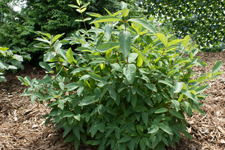 | 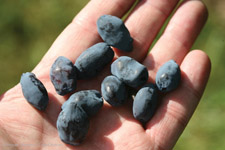 | 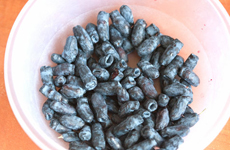 |
| Variety | Sweetness | Fruit Size | Use | Pollinator | Season |
| Yezberry® Maxie™ | Tangy Sweet | Largest | Fresh Processed | Any other Yezberry® | Late |
| Yezberry® Solo™ | Tangy Sweet | Large | Fresh Processed | Any other Yezberry® | Late |
| Yezberry Honey Bunch® | Sweet | Large | Fresh Processed | Any other Yezberry® | Late |
| Yezberry Sugar Pie® | Sweet | Large | Fresh Processed | Any other Yezberry® | Late |
Grow superfruits in your own backyard. Vegetable gardening has been hot for a few years, and now gardeners are already growing their own fruit, too. Goji Berries and Sweetberry Honeysuckle are the rage, popular for their antioxidants and ohter potential health benefits.
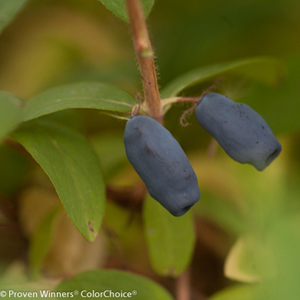 | 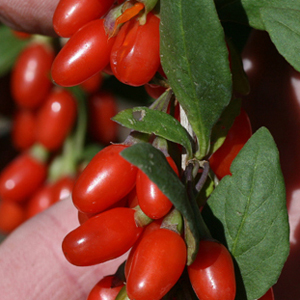 |
| Yazberry™ Lonicera caerulea | Lifeberry™ Lycium barbarum |
| For best fruit production plant more than one variety | A pollinator is not needed. |
| Zone: Hardy to USDA zone 1; heat tolerant to AHS zone 6 | Zone: hardy to USDA zone 5; heat tolerant to AHS zone 9 |
| Exposure: Full Sun (6+ hours) | Exposure: Full sun is best, but tolerates a bit of shade. |
| Height: 5-7' | Height: 5-6' |
| Recipes | Recipes |
| Care | Care |
| FAQ | FAQ |
Though they sound exotic and are most often found with a high price tag in health food stores, these berries are actually easy to grow, hardy plants. If they weren’t, well, we wouldn’t have added them to the line of Proven Winners ColorChoice® Flowering Shrubs. These exceptional strains were specially selected for you and have been grown for centuries for its purported health-giving properties and brilliant fruit color.



